Proton Therapy Market Research, 2031
The global proton therapy market size $438.33 million in 2021, and is projected to reach $1.6 billion by 2031, growing at a CAGR of 13.65% from 2022 to 2031. Proton therapy is the most precise and advanced form of radiation therapy. It is widely used in treatment of cancer. It offers significant benefits over conventional radiation therapy, in terms of efficacy and limited side effects. It is a painless, non-invasive treatment that helps patients retain their quality of life and return to normal activities quickly. It allows physicians to deliver full or higher treatment dosages and destroy the main tumor site without causing harm to surrounding healthy tissues or organs. Major limitations of photon therapy or another particle therapy are overcome by proton therapy. Advancements in technology have increased adoption of proton therapy for treatments of various cancers across the globe.
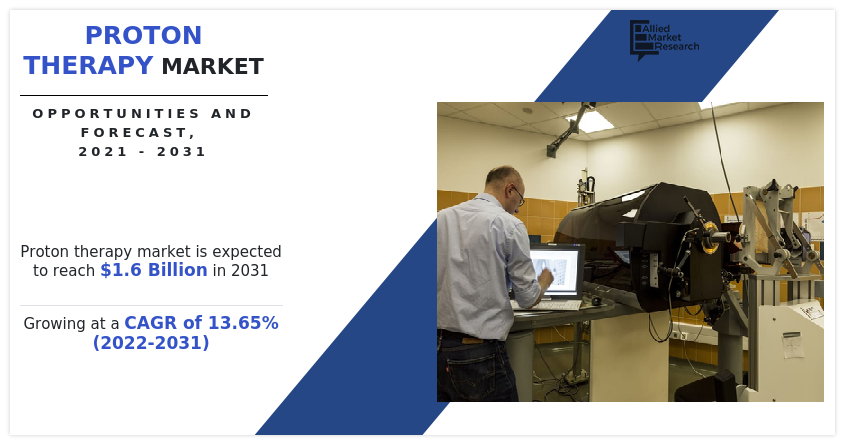
Increase in demand for proton therapy is anticipated to increase globally during the forecast period, owing to increase in prevalence of cancer, surge in number of awareness campaigns regarding benefits of proton therapy, and technological advancements in proton therapy devices. Moreover, patients are eager to know more about proton therapy treatment process and increase in recognition of proton therapy drive growth of the market, globally. However, higher cost of proton therapy is anticipated to hamper the market growth. In addition, proton therapy devices are very larger in size required large space with dedicated areas. The setup cost is exclusive of the device cost, which further increases investments, thereby restraining growth of this market. Conversely, introduction of proton therapy in emerging economies is expected to offer lucrative proton therapy market opportunity for the key players in the market.
The proton therapy market is segmented on the basis of indications, product type, end user, and region. On the basis of indications, the market is classified into head & neck cancer, central nervous system cancer, prostate cancer, breast cancer, and others. On the basis of product type, it is segmented into accelerator, beam transport system, beam delivery system, nozzle & image viewers, and patient positioning system. On the basis of end user, it categorized into hospitals, proton therapy centers, and others. Furthermore, on the basis of region, the market is analyzed across North America, Europe, Asia-Pacific, and LAMEA.
Segment Review
The central nervous system cancer segment was the major revenue contributor in 2021, and is anticipated to continue this trend during the forecast period, owing to surge in prevalence of CNS cancer, and favorable government regulations toward CNS cancer therapeutics. On the other side, the breast cancer is projected to exhibit the fastest proton therapy market growth during the forecast period, owing to increase in prevalence of breast cancer and increased preference for advance therapies by healthcare professionals further boost growth of the market.
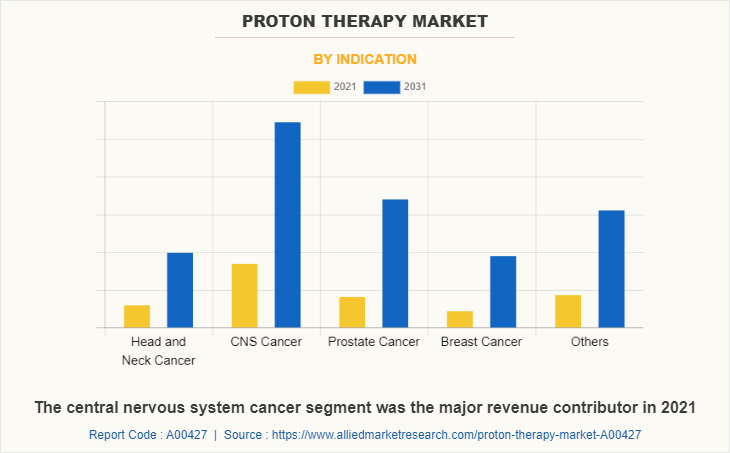
The accelerator segment held largest proton therapy market share in 2021, and is anticipated to continue this trend during the forecast period, owing to increase in prevalence of cancer, cost advantage as compared to outsourced radioactive tracers, and availability of technologically advanced diagnostic devices.
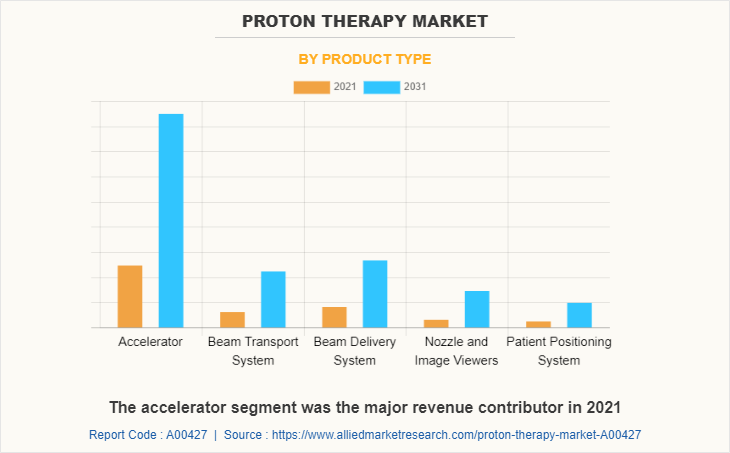
The hospitals segment was the major revenue contributor in 2021, and is anticipated to continue this trend during the proton therapy market forecast period, owing to increase in prevalence of cancer development in healthcare for infrastructure of hospitals, high tech equipment, and self-awareness about diseases.
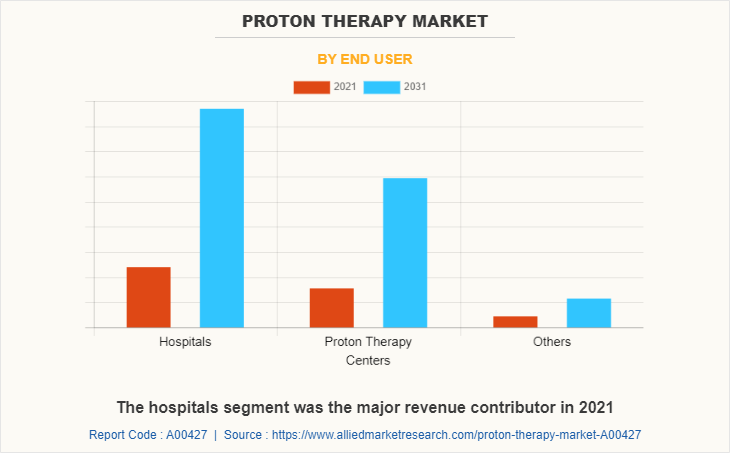
By region, North America held the largest proton therapy market size in 2021, and is anticipated to maintain this trend during the forecast period. Moreover, rise in well-established healthcare system, increase in number of geriatric patients, supportive reimbursement policies in healthcare system, and surge in number of healthcare facilities offering proton therapy propel the market growth.
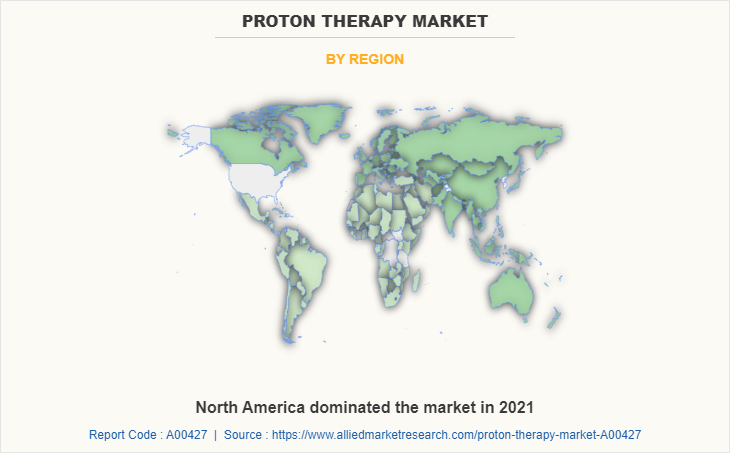
The major companies profiled in the proton therapy industry report include Hitachi, Ltd., Ion Beam Applications S.A., Mevion Medical Systems, Mirion Technologies Ltd., Optivus Proton Therapy, Inc., Provision Healthcare, Pro Tom International, Siemens, Sumitomo Heavy Industries, Ltd., and Toshiba Corporation.
Key Benefits For Stakeholders
- This report provides a quantitative analysis of the market segments, current trends, estimations, and dynamics of the proton therapy market analysis from 2021 to 2031 to identify the prevailing proton therapy market opportunities.
- The market research is offered along with information related to key drivers, restraints, and opportunities.
- Porter's five forces analysis highlights the potency of buyers and suppliers to enable stakeholders make profit-oriented business decisions and strengthen their supplier-buyer network.
- In-depth analysis of the proton therapy market segmentation assists to determine the prevailing market opportunities.
- Major countries in each region are mapped according to their revenue contribution to the global market.
- Market player positioning facilitates benchmarking and provides a clear understanding of the present position of the market players.
- The report includes the analysis of the regional as well as global proton therapy market trends, key players, market segments, application areas, and market growth strategies.
Proton Therapy Market Report Highlights
| Aspects | Details |
| By Indication |
|
| By Product Type |
|
| By End User |
|
| By Region |
|
| Key Market Players | Mirion Technologies, Toshiba Corp., MEVION MEDICAL SYSTEMS, SUMITOMO CORPORATION, Provision Healthcare, OPTIVUS PROTON THERAPY INC., ION BEAM APPLICATIONS, HITACHI LTD., PRONOVA SOLUTIONS LLC., Siemens Ltd |
Analyst Review
Proton therapy, also known as proton radiotherapy, uses high-energy beams to treat tumors. The approach involves depositing of precision dose of high energy radiation in the target tumor. It is widely used in treatment of cancer. Protons scatter less than other forms of X-ray radiation, thereby ensuring less damage in the surrounding healthy issues.
According to CXOs of key companies, adoption of proton therapy devices is anticipated to increase in the future, owing to increase in prevalence of cancer and rise in number of healthcare facilities offering proton therapy Moreover, supply of these devices is anticipated to become streamlined and effective, owing to increase in prevalence of cancer and increase in number of healthcare facilities offering proton therapy. Manufacturers are expected to gain additional income by diversifying their product offerings to cater to the needs of new markets. Premium pricing is projected to remain a source of concern and limit the rate of adoption of these devices; however, availability of funds and grants from governments is expected to drive growth of this market.
As per perspective of CXOs, North America is expected to dominate the global proton therapy market during the forecast period, followed by Europe. In addition, Asia-Pacific and LAMEA are expected to offer lucrative opportunities to the key players during the forecast period.
The global proton therapy market was valued at $438.33 million in 2021, and is projected to reach $1579.39 million by 2031.
Central nervous system cancer is the leading application of Proton Therapy Market.
Trends of Proton Therapy Market include increase in prevalence of cancer and surge in number of awareness campaigns about benefits of proton therapy and technological advancements in radiotherapy devices.
North America is is the largest regional market for Proton Therapy Market.
The top companies to hold the market share in Proton Therapy Market include Hitachi, Ltd., Ion Beam Applications S.A., Mevion Medical Systems, Mirion Technologies Ltd., Optivus Proton Therapy, Inc., Provision Healthcare, Pro Tom International, Siemens, Sumitomo Heavy Industries, Ltd., and Toshiba Corporation.
Loading Table Of Content...



